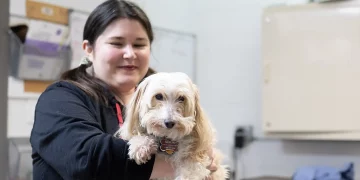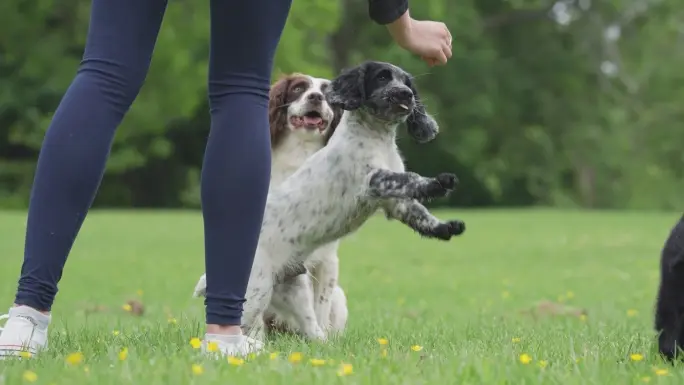Training your pet to follow basic commands is one of the most important aspects of responsible pet ownership. Not only does it create a stronger bond between you and your pet, but it also helps ensure their safety and allows them to be better behaved in different situations. Training basic commands like “sit,” “stay,” “come,” and “leave it” can make life with your pet much easier and more enjoyable. Here’s how to start training your pet the basics.
1. Start Early
While puppies and kittens are ideal candidates for training, it’s never too late to teach your pet new tricks, even if they’re older. However, younger pets tend to have shorter attention spans and may need more frequent, shorter training sessions. Regardless of your pet’s age, consistency and patience are key.
- Puppies/Kittens: Start training your puppy or kitten as early as possible, around 8 weeks old. The earlier you begin, the easier it will be for them to learn.
- Older Pets: Even adult dogs and cats can learn basic commands. Older pets may take longer to train but can still benefit from regular training sessions.
2. Set a Positive Training Environment
Creating the right environment is crucial for effective training. Choose a quiet, distraction-free area for your sessions, especially in the beginning. If your pet is distracted by noise, other animals, or people, it will be harder for them to focus on you and the commands you’re trying to teach.
- Calm Environment: Start in a calm room with no distractions. As your pet learns, you can gradually increase distractions.
- Comfortable Space: Make sure your pet is comfortable, as they’ll be more likely to focus and respond better to your commands.
3. Use Positive Reinforcement
Positive reinforcement is one of the most effective methods for training pets. This involves rewarding your pet with treats, praise, or toys when they perform the desired behavior. This encourages your pet to repeat the behavior to receive the reward.
- Treats: Use small, soft treats that your pet loves. Treats should be easy to consume quickly so that training sessions aren’t interrupted.
- Praise and Affection: Some pets respond just as well to verbal praise and affection as they do to food rewards. Be enthusiastic when praising your pet, as positive reinforcement goes beyond just the treat.
- Toys and Play: For some pets, especially dogs, playing with a favorite toy or engaging in a game of tug-of-war can be an excellent reward.
4. Focus on One Command at a Time
It’s important not to overwhelm your pet with too many commands at once. Start with one command and master it before moving on to another. This will prevent confusion and help your pet understand the specific action you’re asking for.
5. Keep Training Sessions Short and Fun
Pets, especially young ones, have short attention spans. Keep training sessions to about 5 to 10 minutes, and break them into multiple shorter sessions throughout the day. This will keep your pet engaged without overwhelming them.
- Frequent Sessions: Instead of one long session, train your pet several times a day in short bursts. Regular repetition helps reinforce learning.
- Play Breaks: Incorporating playtime in between training can make the sessions more enjoyable for your pet.

6. Train Basic Commands Step by Step
Here are some of the most common basic commands you can start with and how to train them:
“Sit” Command
The “sit” command is often the first and easiest command to teach. Here’s how to teach it:
- Get Your Pet’s Attention: Start by showing your pet a treat. Hold it just above their nose so they can smell it.
- Move the Treat: Slowly move the treat upward, and your pet will naturally sit down as they look up at the treat.
- Say “Sit”: As your pet’s bottom touches the ground, say the word “sit” clearly. Immediately reward them with the treat and praise.
- Repeat: Practice several times in short bursts. Gradually, your pet will associate the word “sit” with the action.
“Stay” Command
Once your pet understands “sit,” you can begin teaching them to “stay.”
- Have Your Pet Sit: Start with your pet in a sitting position.
- Hold Your Hand Up: With a flat hand facing your pet’s face, say “stay” in a calm but firm voice.
- Take a Step Back: Slowly take one step back. If your pet stays in position, return to them, give them a treat, and praise them.
- Increase the Distance: Gradually increase the distance and duration of the “stay” command. Eventually, you can move to other areas or around distractions.
“Come” Command
The “come” command is an essential one for safety reasons, especially when you’re outside.
- Get a Leash or Long Lead: Use a leash or long line to control your pet’s movements when learning this command.
- Use a Command and Call Them: Say your pet’s name followed by the word “come.” Encourage them to move toward you by walking backward and calling their name in a happy tone.
- Reward When They Approach: Once your pet comes to you, immediately reward them with praise and a treat.
- Gradually Increase Distance: Over time, increase the distance and add distractions, such as other pets or people, while ensuring your pet returns when called.
“Leave It” Command
The “leave it” command is helpful when your pet picks up something they shouldn’t, such as food or dangerous objects.
- Start with a Treat: Hold a treat in your hand and let your pet sniff it, but don’t give it to them.
- Say “Leave It”: Once your pet is focused on the treat, say “leave it” firmly. Wait for them to stop trying to get the treat.
- Reward: When your pet stops trying to take the treat, praise them and give them a different reward. The key is to wait until they have stopped and then reward them for ignoring the object.
7. Be Consistent with Commands
Consistency is key when training your pet. Always use the same words and actions for each command. If you change the word or how you perform the action, your pet might get confused and struggle to learn the behavior.
- Same Command Word: Always use the same word for each command (e.g., always say “sit,” not “sit down” or “sit now”).
- Same Tone of Voice: Use a calm and consistent tone when giving commands, as pets learn tone and volume.
- Consistency from Everyone: Ensure that everyone in your household uses the same commands and methods when training your pet to avoid confusion.
8. Avoid Punishment
Never use punishment as a method of training. Pets respond much better to positive reinforcement than they do to negative reinforcement. Yelling, hitting, or using aversive techniques can cause fear and anxiety in your pet, which will hinder the training process.
- Stay Positive: Focus on rewarding good behavior and redirecting undesirable behavior with positive alternatives.
- Be Patient: Training takes time. Your pet may not get everything right away, but with patience and consistency, they will learn.
9. Gradually Introduce Distractions
Once your pet has learned basic commands in a quiet, controlled environment, it’s time to introduce distractions. Start by training in different rooms or outdoors, where there are more stimuli. Gradually increase the level of distraction, but ensure that your pet can still perform the command before moving on to more difficult situations.
- Different Environments: Practice commands in different places, such as the yard, park, or at a friend’s house.
- Distractions: Introduce distractions like other pets, people, or noises while practicing. This helps your pet learn to focus and obey commands even in busy environments.
10. Know When to Seek Professional Help
If you’re struggling to train your pet, or if they’re showing signs of behavior issues beyond basic obedience, don’t hesitate to seek professional help. Professional trainers can guide you through the process and provide tailored advice for your pet’s specific needs.
Conclusion
Training your pet to follow basic commands is not only fun but essential for creating a well-behaved companion. Start early, keep sessions short, use positive reinforcement, and be consistent with your commands. With patience and dedication, you’ll have a pet who listens and responds to your commands, making your life and theirs much more enjoyable. Remember, training is a long-term commitment that strengthens your bond with your pet, and it’s never too late to start!























































